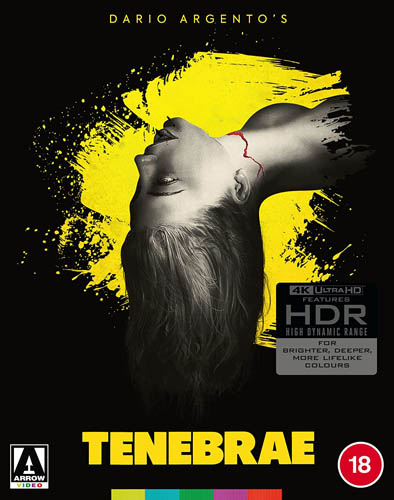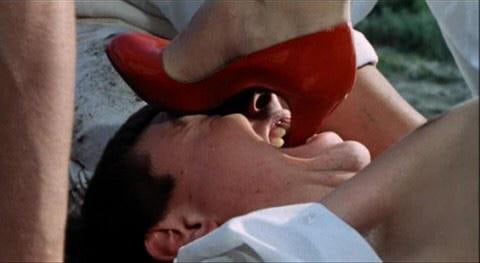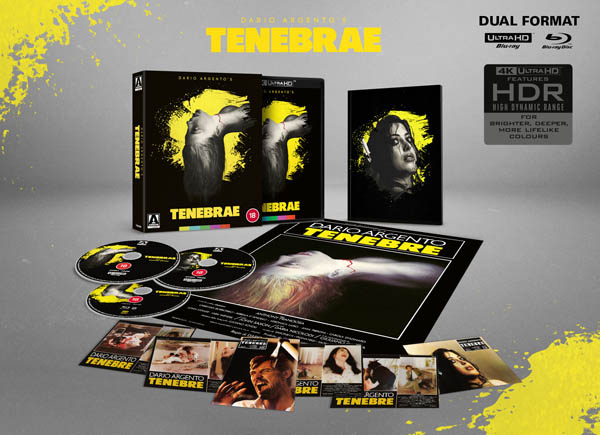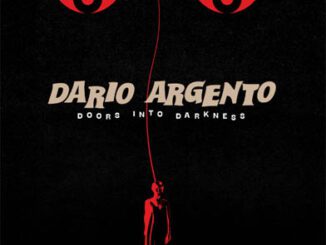Tenebrae, Unsane (1982)
Directed by: Dario Argento
Written by: Dario Argento
Starring: Anthony Franciosa, Daria Nicolodi, Giuliano Gemma, John Saxon

AKA UNSANE
Italy
AVAILABLE ON LIMITED EDITION ARROW VIDEO 4K UHD & BLU-RAY
RUNNING TIME: 101 min/91 min
REVIEWED BY: Dr Lenera, Official HCF Critic
Peter Neal, an American writer of violent mystery novels, arrives in Rome to promote his latest work Tenebrae, and is met at the airport by his literary agent Bullmer and his assistant Anne, but is mystified to find that the clothes in his bag have been slashed up. Unknown to him, his estranged wife Jane McKerrow has followed him to Italy. At the same time, a shoplifter is murdered while having pages from Tenebrae shoved down her throat. The killer then sends Neal a poison pen letter quoting from his book, and soon after rings him up and informs him that more killings, just like ones in Neal’s novels, will take place. Neal is contacted by the police in the form of Detective Giermani and his female partner, Inspector Altieri, and advised not to leave the city….

Though I always enjoy watching them – well, at least until he stopped making films that were good – often wonder if Dario Argento’s love of staging elaborate murder scenes gets out of control at times and holds him back from making the most of his considerable filmmaking talents [or at least the considerable filmmaking talents that he used to have!]. Tenebrae, which seems to feature a killing on average every ten minutes or so, is perhaps the ultimate example of that, and also why his films tend to fall between two stools and don’t tend to attract a mass audience, remaining cult favourites. Many of the folk who would admire things like the great look, innovative camerawork, interesting themes and audacious plotting in his movies are turned off by all that blood and the director’s need to, every now and again, kill someone off in an often brilliantly staged set piece, while many slasher fans find his work too arty and convoluted. Tenebrae is very close to the slasher film in feel, though it’s also one of his cleverest mystery stories and is a fascinating film to look at and study in terms of how it’s been constructed. A debate seems to rage amongst fans whether it or Deep Red is better. I think that Deep Red is an altogether richer experience, though Tenebrae is a braver, tougher, more uncompromising work, its overall coldness clearly intentional.
Argento’s plans to make the third part of his supernaturally themed Three Mothers trilogy changed when Inferno flopped and a series of incidents occured involving an obsessed fan who criticised him for the damaging psychological effects of his work and threatened to kill him.This led him to revive the giallo which he had perfected with Deep Red. Christopher Walken was offered the lead role of Peter Neal but turned it down, while Daria Nicolodi was originally going to play the small role of Jane but took the larger role of Anne when the American actress [her name being a mystery] cast dropped out. The volatile relationship between partners Argento and Nicolodi spread into production, with Argento becoming jealous of Nicolodi’s friendship with star Anthony Franciosa and ordering take after take of their scenes together. Shot on location in Rome and at Elios Studios, Tenebrae suffered trims even from the Italian censors before it was released elsewhere, and Jane’s bloody arm-lopping caused such a fuss that, when Veronica Lario the actress involved married future Italian Prime Minister Silvio Berlusconi, the scene was removed completely and Berlusconi even banned the film for a few years. The belated 1985 US release called Unsane removed ten minutes of footage establishing the characters and their relationships, most of the gore and the film’s striking crane shot. In the UK, the BBFC cut four seconds from the Jane death but the film was still banned as a video nasty and only re-released when a further second was cut until it finally became available uncut in 2003.
The unusual opening has a narrator tell us about somebody being compelled to kill, then throw the book Tenebrae into a fire over which the main titles occur. Unlike the far more leisurely Deep Red, Tenebrae doesn’t waste any time whatsoever and even has its expository dialogue over and done with as quickly as possible. Whenever I watch the film, I always think that it could have done with a bit more characterisation, though the feeding to the viewer of subtle little touches is expertly done and a model of economy. The first murder happens almost immediately, the violence proceeded by a pointless but unnerving bit where the victim-to-be is harassed by a pervy old man who is initially groping at her from the other side of a fence before actually getting through to her side, a scene paralleled by a later one when another person about to be killed is attacked by a dog, which is also the other side of a fence at first. Both scenes are pointless in a way but add to the atmosphere of unease that Argento superbly creates with this film. In a way, it’s one of his more frightening pictures, because this killer can strike at any time and in any place, the most startling example of this being when a man is murdered in a busy Roman square in broad daylight, a scene which is brilliantly built up and staged in a way that would have made Alfred Hitchcock jealous, with all manner with lots of little things going on around the person as he sits about to be murdered. Then a woman walks towards him, a woman who we think is going to be the one who kills him….only for the knife to suddenly go into him from a totally different direction!

Tenebrae has an ingeniously put together plot [the gimmick of a killer offing victims in ways inspired by a writer’s novels was reused in Basic Instinct], though it’s something which is easy to forget as much of the film consists of introducing another character and a few scenes later killing this character off. I’d like the film to have had more scenes with Detective Giermani, who is a fan of mystery novels including Neal’s and who even quotes Conan Doyle, and Inspector Altieri, who are investigating the mystifying case and who, aside from a few tiny bits with Bullmer and his hat, provide the movie’s only real warmth. Nonetheless, the idea of having the person who is obviously the killer being killed off himself, only for the murders to continue, is an inspired one, and this time it’s not the hero who witnesses something and tries to work out what he has seen, but a subsidiary character. Major cast members are then killed off at an almost amusing rate and the final reveal is guessable a few scenes before it actually occurs, but the tension and feeling of dread is palpable. The afore-mentioned arm-lopping moment provides a terrific jump scare as the axe smashes through the window behind where the victim is sitting, and is truly shocking the first time you see it as blood literally paints the walls. Argento is still happy to cut away from some of the gruesome detail when he wants to, even if Tenebrae is still an extremely vicious film with its many deaths by knife, axe, rope, and, finally, a weird spiky sculpture which is in a room just so somebody can be impaled on it. By now the film has really got very nihilist and it’s no wonder that the sole surviving character can do nothing but scream a lot in perhaps Argento’s most appropriate close.
The technical highlight of Tenebrae is of course the two and a half minute crane shot, just as two lesbians are about to be murdered, which begins outside a lower apartment window, moves up to the second floor window, up and over the roof of the building, down the other side and to a window on the opposite side of the building. It’s a striking example of bravura style just for the sake of it. Visually the film is notable for the amount of white everywhere, from settings to clothes, Argento’s total avoidance of any recognisable Rome landmarks also helping to create a sterile, almost futuristic feel. He also fills the film with doubles of all kinds, from objects to events to the staging of scenes, emphasising I suppose the dual nature of the two murderers, especially the second one. An especially notable example is the first meeting of Neal and Anne with Giermani and Altieri, where the characters are set up in frame with their dopplegangers. The doubling of Neal and Giermani reaches its climax in the stunning shot when one bends down to reveal the other hidden behind the other. Then there’s the theme of sexual deviancy which is everywhere in this movie, but perhaps especially in the killer’s flashbacks where he recalls being humiliated by a tarty woman [actually a transsexual] and paying her back by slaying her, with the startlingly fetishistic image of the heel of a lady’s red shoe going into a mouth. At times Argento seems to be defending himself in the film against charges of misogyny [he does appear to enjoy killing off women more than men even though many men die in his films too, but I would say he’s more misanthropic then sexist] when Neal is attacked for the same, though I wish these particular moments had gone a bit deeper.
As often with Argento, the acting generally isn’t great – Franciosa is okay but not much more, and even the usually fine Nicolodi [dubbed by Theresa Russell] struggles with an underwritten part – though some of the dialogue, especially uttered by victims-to-be, isn’t too good either. Argento does fill his film with attractive looking women though. The very loud score by Goblin [well, three of the band members] is mostly synthesiser dominated and less rock than disco in style. It’s also simpler than normal, but the driving main theme is very catchy and much of the rest of the score is quite danceable as well as serving well as musical backing. Two unused tracks from the Dawn Of The Dead score appear as source music. Tenebrae has its awkward moments and a callousness that means that it’s hard to love, yet, having just watched it again, it could be the quintessential Argento film, even if is isn’t the best [I wouldn’t quite place it in the top five, but maybe the top ten], with all his good and just a smidgeon of his bad qualities as a filmmaker in abundance, and the one where the themes that recur throughout his career including repressed trauma, the fetishism of violent death, voyeurism, sexual deviancy, and events where something is missing to make them make sense, are most in evidence.

Special Features Reviewed by David S. Smith
The three disc, limited edition 4K UHD and Blu-Ray dual format release of TENEBRAE from Arrow Video comes jam-packed with juicy extras that collectors will adore. The release features limited edition packaging with reversible sleeve featuring original and newly commissioned artwork by Obviously Creative Illustrated; a collector’s booklet featuring writing on the film by filmmaker Peter Strickland and Argento biographer Alan Jones, an interview with cinematographer Luciano Tovoli and a new, in-depth analysis of the film by critic Ashley Lane; a fold-out double-sided poster featuring original and newly commissioned artwork by Obviously Creative; and six double-sided, postcard-sized lobby card reproduction artcards.
The Arrow Video limited edition release also comes with a whole host of extras on the discs.
Disc 1 – Special Features
- 4K (2160p) UHD Blu-ray™ presentation in Dolby Vision (HDR10 compatible). The film looks and sounds excellent – a decent upgrade from the previous transfer.
- Original Italian and English front and end titles and insert shots
- Restored original lossless mono Italian and English soundtracks
- English subtitles for the Italian soundtrack
- Optional English subtitles for the deaf and hard of hearing for the English soundtrack
- Yellow Fever: The Rise and Fall of the Giallo (90 mins) – A feature-length documentary charting the genre from its beginnings to its influence on the modern slasher film. This is the sort of thing I wish I’d watched years ago! It’s excellently put together and would have helped me appreciate the conventions of this most batshit of genres and how it bridges the gap between two of my favourites: Agatha Christie and Jason Voorhees. It is an exhaustive account featuring a wealth of footage and interviews, including some of Italian cinema’s biggest names such as Dario Argento, Umberto Lenzi, Luigi Cozzi and more.
- “Unsane” end credits sequence featuring the song Take Me Tonight by Kim Wilde – that’s right, the Kids In America singer. It’s not terrible, but it makes for a cheesier vibe.
- Being the Villain, a newly edited archival interview with actor John Steiner (16 mins) – He goes through his whole career, from his beginnings as a thespian in England to his success in Italy. Entertaining, self-deprecating and interesting anecdotes with Orson Welles among others.
- Promotional materials – an international trailer, a Japanese trailer and promotional materials for Spain, Japan, Italy, Germany and USA among other places.
- Alternate opening credits sequence – funky but slightly less effective.
Commentaries:
- Audio commentary by authors and critics Alan Jones (of FrightFest fame) and Kim Newman (who did the horror history lesson Nightmare Movies). I was really looking forward to this one, and it delivers two huge Argento fans and also clearly friends in real life. Passionate, insightful and funny.
- Audio commentary by Maitland McDonagh, author of Broken Mirrors/Broken Minds: The Dark Dreams of Dario Argento
- Audio commentary by Argento expert Thomas Rostock
Archival interviews:
- Voices of the Unsane (18 mins) – an archival featurette containing interviews with writer/director Dario Argento, actresses Daria Nicolodi and Eva Robins, cinematographer Luciano Tovoli, composer Claudio Simonetti and assistant director Lamberto Bava. Lots about the planning, and the lighting techniques etc. But what I found particularly interesting is the reflections on how Argento’s career decisions, namely his Three Mothers trilogy, were received in Italy and America. The conflict between these two audiences is an integral part of the story behind the film and this new version.
- Out of the Shadows (13 mins) – an archival interview with Maitland McDonagh. She is a critic who has written extensively about Argento. An interesting reflection on his gender politics and where Tenebrae sits in his evolution as a filmmaker.
- The Unsane World of Tenebrae (15 mins) – an archival interview with Dario Argento. Here he touches on expressing his dark side through cinema, how Tenebrae was a meta-joke and the importance of location.
- A Composition for Carnage (10 mins) – an archival interview with Claudio Simonetti of Goblin fame. He speaks about working with Argento, why he doesn’t resent Keith Emmerson and combining rock with electronica.
- Screaming Queen (16 mins) – an archival interview with Daria Nicolodi, who played the part of Anne. She doesn’t hold back on criticising some of her past roles and goes into detail about the odd experience of seeing herself dubbed. She also explains the infamous bloody arm scene.
- A very brief, cheery introduction to the film by Claudio Simonetti.
Disc 2 – Special Features
- Unsane version – A shorter 90-minute cut of the film made for America. Punchier, less dialogue and more sanitised kill scenes (particularly towards the end where some of the best footage is removed). Very interesting to watch and compare. Note that this cut was recreated for this release from the new 4K restoration of the full-length version, so it does not look any less polished.
- Two audio options. There’s a complete recreation of the original theatrical experience, complete with jump cuts and sudden audio shifts made due to edits. Or a new, more seamless edit that newly created for this release. Both are in restored lossless English mono, i.e., they sound good.
- Two audio options: a recreation of the original theatrical experience, complete with jump cuts and sudden audio shifts, and a new, more seamless edit created for this release, both in restored lossless English mono
- Original “Take Me Tonight” stereo EP recording for the person who can’t get enough Kim Wilde.
- Optional English subtitles for the deaf or hard of hearing.
Disc 3 – Special Features
- 1080p Blu-Ray presentation of the original version of the movie
- All the same special features as Disc 1 but on Blu-Ray instead.







terrific read.
my favourite argento, even if it isn’t yours, and it’s good to read a different angle on it.
Thanks very much for your kind comment. It’s always a great pleasure to read a comment from a reader who really appreciates what we write on HCF.
One of the reasons Tenebrae focuses on a futuristic set is because Argento claimed it does take place about 15 years in the future. The Rome of Tenebrae is experiencing an economic boom after a world war, which had reduced the population, but Argento wanted that aspect to be buried in the backstory as opposed to a title card boasting “1997” or other in-your-face futuristic elements.